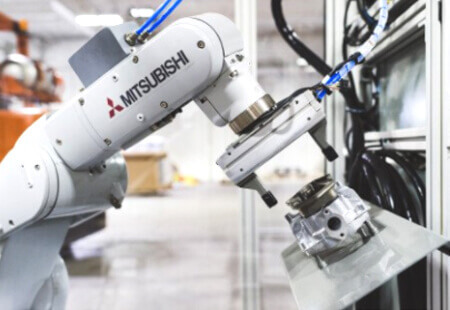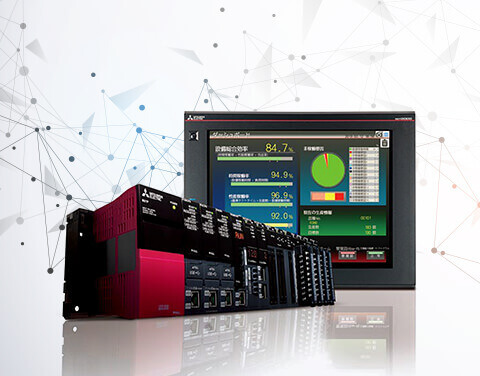Programmable Controllers
เครือข่าย MELSEC
The MELSEC network - launching a network industrial revolution.
MELSEC responds to the new demands of the industrial network
and optimizes the entire system by providing the services needed at production
sites such as high-speed control, large-volume data control, flexible wiring,
simple startup and maintenance.
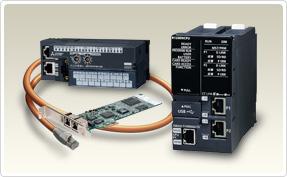
Choose the optimal network to meet your needs

CC-Link IE TSN supports TCP/IP communications and applies it to industrial architectures through its support of TSN enabling real-time communications. With its flexible system architecture and extensive setup and troubleshooting features make CC-Link IE TSN ideal for building an IIoT infrastructure across the manufacturing enterprise.
*TSN: Time Sensitive Networking
*IIoT: Industrial Internet of Things
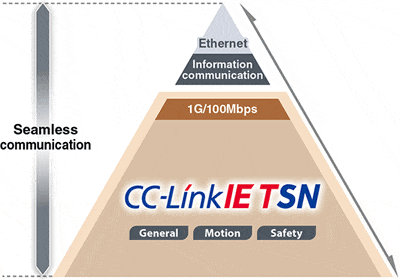
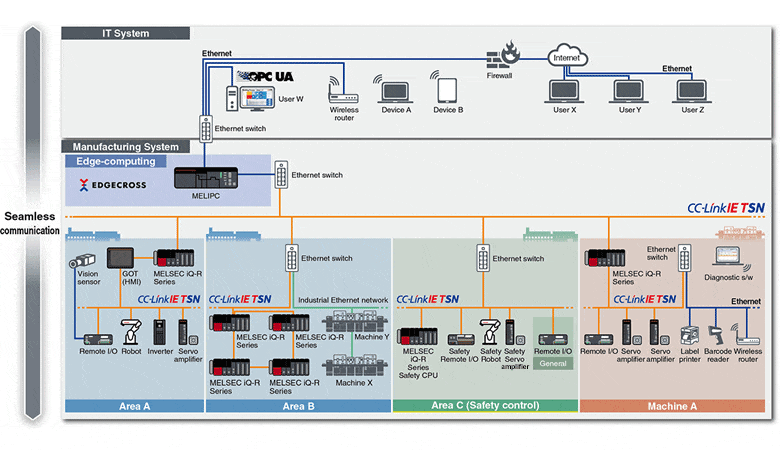

A high-speed and large capacity Ethernet-based integrated open network that supports a mixed environment comprised of control data and the administration data of equipment. Seamless connection is possible for the distributed control of controllers, I/O control, motion control and safety control.
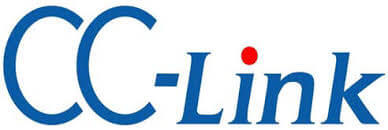
An open field network that can be used with an ample range of partner products, numbering in excess of 1,000 models, from wire saving units to safety equipment.
CC-Link IE Controller Network
This controller-to-controller network enables high-speed communication and high-volume transmission, with seamless communication not interrupted by layers.
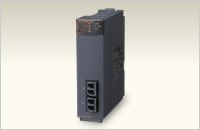
CC-Link IE Field Network
This high-speed field network extends from I/O control to controller branched control, and enables wiring which matches the device layout.
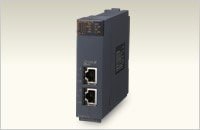
CC-Link
This high-speed field network is capable of control and information handling.
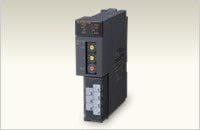
CC-Link Safety
This safety field network constructs a safety system to protect production sites from dangers.
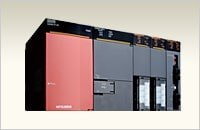
CC-Link/LT
Internal and external wire reduction network to eliminate onsite problems such as overly complex wiring work or wiring errors.
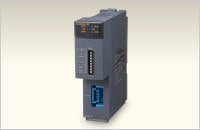
Ethernet
This excellent quality network connects departments throughout the factory.
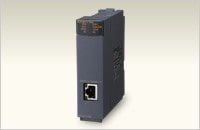
AnyWire
This flexible sensor network uses universal wires and robot cables to enable branched control of sensors and actuators.
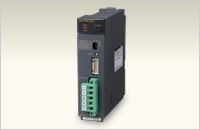
SSCNET
Experience flexible handling of long-distance wiring, with this fiber optic cable high-speed, high-performance Motion Controllers network.

MELSECNET/H
Control network for connecting manufacturing devices.
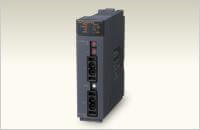
MODBUS
MODBUS module for connection with MODBUS compatible devices such as temperature controllers and measuring instruments.
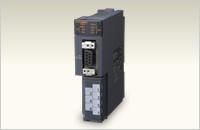
PROFIBUS
Interface module for PROFIBUS network.
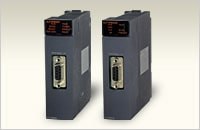
DeviceNet
Interface module for DeviceNet network.
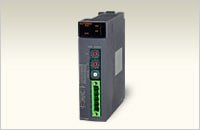
Serial communication
Serial communication module allowing PLC data collection/modification, monitoring/control and measurement data collection.
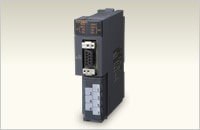
FL-net(OPCN-2)
Interface module connectable to FL-net network.
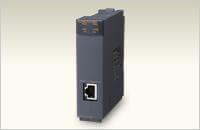
AS-i
Interface module for AS-i network.
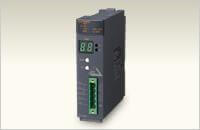
CC-Link IE Field Network performance specifications
| Item | MELSEC iQ-R Series R04ENCPU R08ENCPU R16ENCPU R32ENCPU R120ENCPU RJ71EN71 | MELSEC iQ-R Series master/local module RJ71GF11-T2 | MELSEC-Q Series master/local module QJ71GF11-T2 | MELSEC-L Series master/local module LJ71GF11-T2 | Network interface board Q80BD-J71GF11-T2, Q81BD-J71GF11-T2 | |
|---|---|---|---|---|---|---|
| Communication speed | 1 Gbps | |||||
| Maximum stations per network | 121 stations (1 master station. 120 slave stations) | |||||
| Connection cable | Ethernet cable (Category 5e or higher, double shielded/STP), straight cable | |||||
| Overall cable distance | Line type: 12,000 m (When 1 master station and 120 slave stations are connected) Star type: Depends on system configuration*1 Ring type: 12,100 m (When 1 master station and 120 slave stations are connected) | |||||
| Maximum station-to-station distance | 100 m | |||||
| Maximum number of networks | 239 | |||||
| Network topology | Line type, star type*2, ring type | |||||
| Communication method | Token-pass | |||||
| Maximum link points per network*3 | ||||||
| RX | 16384 points, 2K bytes | |||||
| RY | 16384 points, 2K bytes | |||||
| RWr | 8192 points, 16K bytes | |||||
| RWw | 8192 points, 16K bytes | |||||
| Maximum link points per station*3 | ||||||
| Master station | RX | 16384 points, 2K bytes | ||||
| RY | 16384 points, 2K bytes | |||||
| RWr | 8192 points, 16K bytes | |||||
| RWw | 8192 points, 16K bytes | |||||
| Local station*4 | RX | 2048 points, 256 bytes | ||||
| RY | 2048 points, 256 bytes | |||||
| RWr | 1024 points, 2048 bytes | 256 points, 512 bytes | ||||
| RWw | 1024 points, 2048 bytes | 256 points, 512 bytes | ||||
| Intelligent device station | RX | 2048 points, 256 bytes | ||||
| RY | 2048 points, 256 bytes | |||||
| RWr | 1024 points, 2048 bytes | 256 points, 512 bytes | ||||
| RWw | 1024 points, 2048 bytes | 256 points, 512 bytes | ||||
| Remote device station | RX | 128 points, 16 bytes | ||||
| RY | 128 points, 16 bytes | |||||
| RWr | 64 points, 128 bytes | |||||
| RWw | 64 points, 128 bytes | |||||
| Safety communications | ||||||
| Maximum number of safety connections per network | — | 1814 connections | — | |||
| Maximum number of safety connections per station | — | 120 connections | — | |||
| Maximum number of link points per safety connection | — | 8 words (input: 8 words, output: 8 words) | — | |||
| Transient transmission capacity | ||||||
| Transient transmission capacity | 1920 bytes maximum | |||||
| Item | MELSEC iQ-R Series simple motion module RD77GF4 RD77GF8 RD77GF16 RD77GF32 | MELSEC-Q Series simple motion module QD77GF4 QD77GF8 QD77GF16 | |
|---|---|---|---|
| Communication speed | 1 Gbps | ||
| Maximum stations per network | 121 stations (1 master station. 120 slave stations) | ||
| Connection cable | Ethernet cable (Category 5e or higher, double shielded/STP), straight cable | ||
| Overall cable distance | Line type: 12,000 m (When 1 master station and 120 slave stations are connected) Star type: Depends on system configuration*1 | ||
| Maximum station-to-station distance | 100 m | ||
| Maximum number of networks | 239 | ||
| Network topology | Line type, star type*2 | ||
| Communication method | Token-pass | ||
| Maximum link points per network*3 | |||
| RX | 16384 points, 2K bytes | 8192 points, 1K bytes | |
| RY | 16384 points, 2K bytes | 8192 points, 1K bytes | |
| RWr | 8192 points, 16K bytes | 1024 points, 2K bytes | |
| RWw | 8192 points, 16K bytes | 1024 points, 2K bytes | |
| Maximum link points per station*3 | |||
| Master station | RX | 16384 points, 2K bytes | 8192 points, 1K bytes |
| RY | 16384 points, 2K bytes | 8192 points, 1K bytes | |
| RWr | 8192 points, 16K bytes | 1024 points, 2K bytes | |
| RWw | 8192 points, 16K bytes | 1024 points, 2K bytes | |
| Local station*4 | RX | 2048 points, 256 bytes | — |
| RY | 2048 points, 256 bytes | — | |
| RWr | 256 points, 512 bytes | — | |
| RWw | 256 points, 512 bytes | — | |
| Intelligent device station | RX | 2048 points, 256 bytes | |
| RY | 2048 points, 256 bytes | ||
| RWr | 256 points, 512 bytes | 1024 points, 2048 bytes | |
| RWw | 256 points, 512 bytes | 1024 points, 2048 bytes | |
| Remote device station | RX | 128 points, 16 bytes | |
| RY | 128 points, 16 bytes | ||
| RWr | 64 points, 128 bytes | ||
| RWw | 64 points, 128 bytes | ||
| Safety communications | |||
| Maximum number of safety connections per network | — | ||
| Maximum number of safety connections per station | — | ||
| Maximum number of link points per safety connection | — | ||
| Transient transmission capacity | |||
| Transient transmission capacity | 1920 bytes maximum | ||
*1: A hub is required to use the star type wiring. Up to 20 hubs can be connected.
*2: Line and star types can also be mixed.
*3: Remote input RX: Bit data input from a slave station to the master station
Remote output RY: Bit data output from the master station to a slave station
Remote register RWr: 16-bit (word) unit data output from the master station to a slave station
Remote register RWw: 16-bit (word) unit data output from the master station to a slave station
*: May partially differ for local stations
*4: Number of link points allocated by the master station. A local station can also use other link points to receive data from other stations.
For further details, please refer to the relevant product manuals.
CC-Link IE Control Network performance specifications
| Item | MELSEC iQ-R Series R04ENCPU R08ENCPU R16ENCPU R32ENCPU R120ENCPU RJ71EN71 | MELSEC iQ-R Series RJ71GP21-SX | MELSEC-Q Series QJ71GP21-SX QJ71GP21S-SX | Network interface board Q80BD-J71GP21-SX Q80BD-J71GP21S-SX Q81BD-J71GP21-SX Q81BD-J71GP21S-SX | |
|---|---|---|---|---|---|
| Communication speed | 1 Gbps | ||||
| Maximum stations per network | 120 (1 control station, 119 normal stations)*5 | ||||
| Connection cable | Ethernet cable (Category 5e or higher, double shielded/STP), straight cable | Multi-mode optical cable | |||
| Laser class (JIS C 6802, IEC 60825-1) | — | Class 1 laser product | |||
| Overall cable distance | Line type: 11,900 m*6 Star type: Depends on system configuration Ring type: 12,000 m*6 | 66,000 m*6 | |||
| Maximum station-to-station distance | 100 m | 550 m | |||
| Maximum number of networks | 239 | ||||
| Maximum number of groups | 32 | ||||
| Network topology | Line type, star type*7, ring type | Duplex loop ring | |||
| Communication method | Token-pass | Token-ring | |||
| Maximum link points per network*8 | |||||
| LB | 32768 points, 4K bytes | 32768 points, 4K bytes*9 | |||
| LW | 131072 points, 256K bytes | 131072 points, 256K bytes*10 | |||
| LX | 8192 points, 1K bytes | ||||
| LY | 8192 points, 1K bytes | ||||
| Communication speed*8 (Regular mode) | |||||
| LB | 16384 points, 2K bytes | ||||
| LW | 16384 points, 32K bytes | ||||
| LX | 8192 points, 1K bytes | ||||
| LY | 8192 points, 1K bytes | ||||
| Communication speed*8 (Extended mode*11) | |||||
| LB | 32768 points, 4K bytes | ||||
| LW | 131072 points, 256K bytes | ||||
| LX | 8192 points, 1K bytes | ||||
| LY | 8192 points, 1K bytes | ||||
| Transient transmission capacity | |||||
| Transient transmission capacity | 1920 bytes maximum | ||||
*5: Under CC-Link IE Control Network, the number of connectable normal stations per network differs by the CPU module used in the control station.
For the details, please refer to the manual of the module used in the control station.
*6: When 120 stations are connected.
*7: Line and star types can also be mixed.
*8: Link relay LB: Bit data transmitted from stations in the network.
Link register LW: 16-bit (word) unit data transmitted from stations in the network.
Link input LX: Data input from a station to the I/O master in the same block.
Link output LY: Data output from the I/O master station to another station in the same block.
*9: 16384 points and 2K bytes for the basic model QCPU and the MELSEC-QS Series Safety CPU.
*10: 16384 points and 32K bytes for the basic model QCPU and the MELSEC-QS Series Safety CPU.
*11: To use the extended mode, all the stations must be compatible with the extended mode.
CC-Link IE Field Network Basic performance specifications
| Item | MELSEC iQ-R Series | MELSEC-Q Series | MELSEC-L Series | MELSEC iQ-F Series | |
|---|---|---|---|---|---|
| R□CPU R□ENCPU | Q□UDVCPU | L□CPU | FX5U FX5UC | ||
| Communication speed | 100 Mbps | ||||
| Maximum stations per network*12 | 64 stations (16 stations × 4 groups) | 16 stations | 6 stations | ||
| Connection cable | Ethernet standard compatible cable, Category 5e or higher (STP cable) | ||||
| Maximum station-to-station distance | 100 m (between a hub and node)*13 | ||||
| Network topology | Star type | ||||
| Communication method | UDP | ||||
| Maximum link points per network*14 | |||||
| RX | 4096 points | 1024 points | 384 points | ||
| RY | 4096 points | 1024 points | 384 points | ||
| RWr | 2048 points | 512 points | 192 points | ||
| RWw | 2048 points | 512 points | 192 points | ||
| Maximum link points per station*14 | |||||
| Master station | RX | 4096 points | 1024 points | 384 points | |
| RY | 4096 points | 1024 points | 384 points | ||
| RWr | 2048 points | 512 points | 192 points | ||
| RWw | 2048 points | 512 points | 192 points | ||
| Slave station*15 | RX | 64 points; up to 256 points can be allocated according to the number of stations | |||
| RY | 64 points; up to 256 points can be allocated according to the number of stations | ||||
| RWr | 32 points; up to 128 points can be allocated according to the number of stations | ||||
| RWw | 32 points; up to 128 points can be allocated according to the number of stations | ||||
*12: Maximum number of slave stations controlled by the master station, depending on the number of allocated slave stations. The total number of allocated stations should not exceed the maximum number of slave stations.
*13: The maximum distance between stations depends on the actual hub used. Please refer to the hub manufacturer's specifications.
*14: Remote input RX: Bit data input from a slave station to the master station
Remote output RY: Bit data output from the master station to a slave station
Remote register RWr: 16-bit (word) unit data output from the master station to a slave station
Remote register RWw: 16-bit (word) unit data output from the master station to a slave station
*15: Number of link points allocated by the master station.
Network specifications comparison
Control level
| Item | CC-Link IE Control Network | MELSECNET/H | |||
|---|---|---|---|---|---|
| Optical duplex loop | Twisted pair | Optical loop method | Coaxial bus method | Twisted bus method | |
| Communication speed [bps] | 1 G | 25 M | 10 M | 10 M (max.) | |
| Maximum stations per network | 120*16 | 65 | 33 | 32 | |
| Maximum link points | |||||
| Per network | 128K*17 | 16K*17 | |||
| Per station | 128K*17 | 16K*17 | |||
| Distance | |||||
| Overall [km] | 66 | 12*18 | 30 | 2.5*19 | 0.1 (10 Mbps) |
| Station-to-station [m] | 550 | 100 | 1000 | 500 | 100 (10 Mbps) |
| Communication | |||||
| Network topology | Duplex loop ring | Star type, line type, ring type | Duplex loop ring | Bus type | Bus type |
| Connection cable | Ethernet cable (Multi-mode optical fiber) | Ethernet cable (Category 5e or higher, double shielded/STP) | Optical fiber cable | Coaxial cable | Twisted pair cable |
Field level
| Item | CC-Link IE Field Network | CC-Link IE Field Network Basic | CC-Link |
|---|---|---|---|
| Communication speed [bps] | 1 G | 100 M | 10 M (max.) |
| Maximum stations per network | 121 | 65*20 | 65*20 |
| Maximum link points | |||
| Per network | 16K*21 | 4K*21 | 4K*21 |
| Per station | 2K*21 | 256*21 (When 4 stations are occupied) | 256*21 (When 4 stations are occupied) |
| Distance | |||
| Overall [km] | 12.1*18 | Depends on system configuration | 1.1*19 (10 Mbps) |
| Station-to-station [m] | 100 | 100 | 100 (10 Mbps) |
| Communication | |||
| Network topology | Star type, line type, ring type | Star type | Bus type, T-branch type, star type |
| Connection cable | Ethernet cable (Category 5e or higher, double shielded/STP) | Ethernet cable (Satisfies 100BASE-TX) | Twisted pair cable (CC-Link dedicated cable) |
*16: Value when the extended mode is used.
*17: Value of link register LW (word).
*18: Value when ring connection is used.
*19: Value when a repeater is used.
*20: The maximum stations per network differ according to programmable controller Series.
*21: Value of remote register Rwr + RWw (word).
Cable specifications
CC-Link IE compatible twisted-pair cable*22
| Item | Specifications | |
|---|---|---|
| Twisted-pair cable specifications | Category 5e or higher, (double shielded/STP) straight cable | |
| Standard | Cables that conform to the following standards. ・ IEEE802.3 (1000BASE-T) ・ ANSI/TIA/EIA-568-B (Category 5e) | |
| Connector specifications | Standard | RJ45 connector with shield |
CC-Link IE compatible optical cable*22
| Item | Specifications | |
|---|---|---|
| Optical cable specifications | 1000BASE-SX (MMF) optical cable | |
| Standard | IEC 60793-2-10 Types A1a.1 (50/125 µm multimode) | |
| Transmission loss (max.) | ≤ 3.5 dB/km (λ = 850 nm) | |
| Transmission band (min.) | ≥ 500 MHz・km (λ = 850 nm) | |
| Connector specifications | Duplex LC connector | |
| Standard | IEC 61754-20: Type LC connector | |
| Connection loss | ≤ 0.3 dB | |
| Polished face | PC (Physical Contact) polishing | |
*22: For recommended cables and other information, contact the CC-Link Partner Association.
CC-Link IE Field Network Basic compatible twisted-pair cable
| Item | Specifications | |
|---|---|---|
| Twisted-pair specifications | Category 5e or higher, (STP) straight cable Category 5 or 5e, (STP) cross cable | |
| Standard | Cables that satisfy following standards ・ IEEE802.3 (100BASE-TX) ・ ANSI/TIA/EIA-568-B (Category 5) | |
| Connector specifications | Standard | RJ45 |
Network Topologies*23
*23: CC-Link IE Field Network Basic supports star topology only.
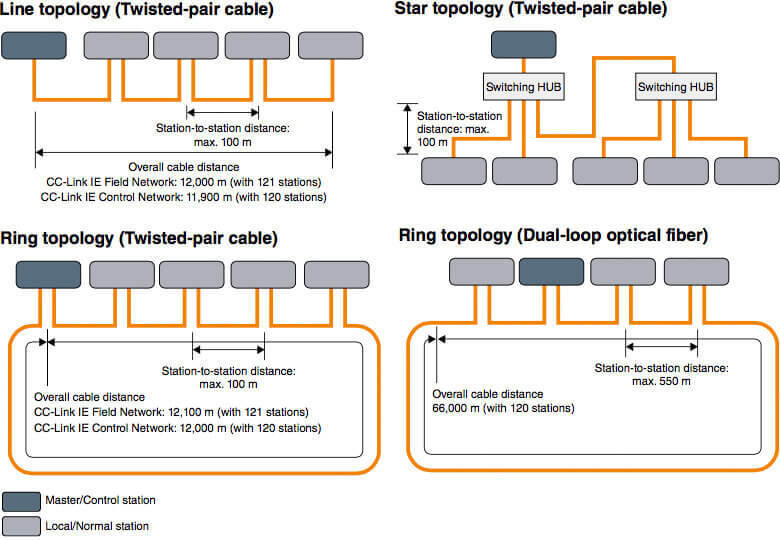
Cyclic transmission
CC-Link IE Field Network*24
One-to-one communication is possible between the master and slave stations. The status of link devices (RY, RWw) within the master station are transmitted to an external device connected to a slave station. Likewise, the status of external devices is transmitted to the master station link devices (RX, RWr) via the slave station.
In the case of local stations, the status of the master station link devices (RY, RWw) is relayed to all local station link devices (RX, RWr) on the network. When an input from a slave or local station is executed, the slave station link devices (RX, RWr) status and local station link devices (RY, RWw) status are stored in the master station link device (RX, RWr), along with other local station link devices (RY, RWw). As a result, all local stations possess the data of other slave stations, similar to the master station.
*24: The data is transmitted in the same method on CC-Link IE Field Network Basic. Note that communication is made between the master station and the slave stations only. No local stations are available on the CC-Link IE Field Basic.
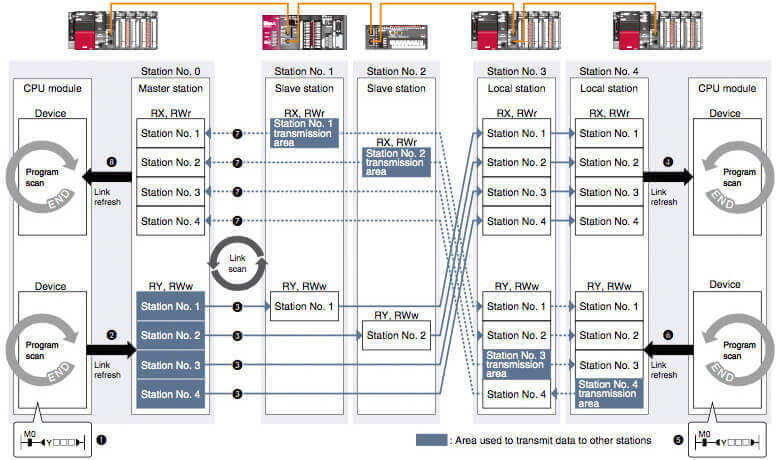
Output from the master station
① In the master station, devices of the CPU module turn ON.
② In the master station, the status of the CPU module devices are stored in the link devices (RY, RWw) by link refresh.
③ The status of the master station link devices (RY, RWw) are then stored in the slave station link devices (RY, RWw), and in the local station link devices (RX, RWr) by link scan.
④ The status of the local station link devices (RX, RWr) are stored in the CPU module devices.
Input from the slave or local station
⑤ In the local station, devices of the CPU module turn ON.
⑥ In the local station, the status of the CPU module devices are stored in its own station link devices (RY, RWw) transmission area.
⑦ The status of the slave station link devices (RX, RWr), and the local station link devices (RY, RWw) are stored in the master station link devices (RX, RWr) by link scan.
⑧ The status of the master station link devices (RX, RWr) are stored in the CPU module devices by link refresh.
CC-Link IE Control Network
Communications using link relays (LB) and link registers (LW)
This function allows each station to write data to its own send range of a link device (LB, LW) to send them to all other stations on the network. The status data of the control station link devices (LB, LW) are stored in the link devices (LB, LW) of each normal station. Likewise, the status of the normal station link devices (LB, LW) is stored in link devices (LB, LW) of the control and other normal stations.
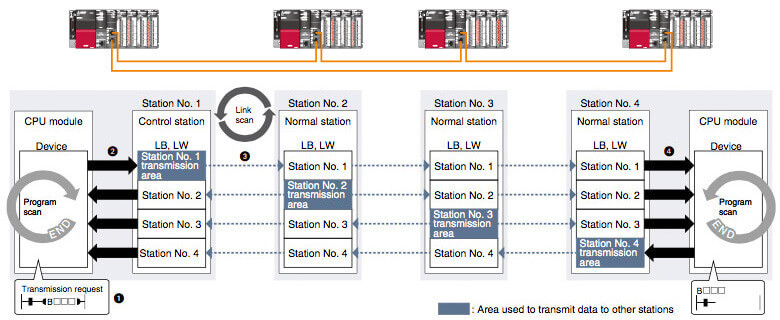
① In the transmitting station, the CPU module devices turn ON.
② In the transmitting station, the CPU module devices status are stored in the link devices (LB, LW) of the CC-Link IE Control Network supporting module by link refresh.
③ The status of the link devices (LB, LW) in the transmitting station are sent to the link devices (LB, LW) of the CC-Link IE Control Network supporting module in the receiving station by link scan.
④ In the receiving station, the status of the link devices (LB, LW) are stored in the CPU module devices.
Transmissions using link inputs (LX) and link outputs (LY)
An I/O master station, which controls link inputs (LX) and link outputs (LY), and another station make one to one communication. LX is the input data transmitted between stations in a block, and LY is the output data transmitted from the I/O master station in a block. The control or normal station can be an I/O master station, and up to two I/O master stations (block 1 and block 2) can be used per network.


